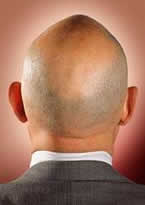Lab-grown cells “cure baldness”
03 Jun 2008, by in HAIR LOSS SCIENCERemaining hair cells are multiplied to fill bald areas Cells grown in the laboratory may offer a possible solution to hair loss, preliminary trials have suggested.
The technique involves taking small amounts of the remaining hair cells, multiplying them, then injecting them into bald areas.
Six months after treatment, 11 out of 19 patients had grown new hair, UK researchers told an Italian conference.
However, a UK specialist said further work would be needed so that the new hair looked right.
“It will revolutionise hair care, I think”
Dr Paul Kemp, Intercytex
Hair loss affects two-fifths of men over 50, and can be a long-term problem for some people following radiotherapy or burns.
Currently available methods of hair transplantation involve taking large clumps of remaining follicles under local anaesthetic and moving them to the desired area, a technique dependent on the amount of hair left, as no new hair is created.
The new method, called “follicular cell implantation”, developed by UK firm Intercytex, claims to be able to provide a limitless supply of replacement hair cells, and, if other trials show it to be safe and effective, could be available within five years.
Doctors take only the dermal papilla cells – cells found in the follicle which are responsible for hair growth.
They are harvested from areas on the back of the head, which usually still have hair growth, and then bathed in a specially-developed chemical in the laboratory, before being placed back into bald areas of the scalp.
The early results suggest that most patients appear to benefit after just a few months, although the numbers involved in the trial are relatively small.
Dr Paul Kemp, Intercytex’s Scientific Officer, said that the presence of the dermal papilla cells encouraged skin cells to start building a brand new hair follicle, or rejuvenated follicles which have stopped producing hair properly.
He said: “It will revolutionise hair care, I think. People will use this when they are starting to go bald – they’ll come and see us, we’ll take a few dermal papilla cells, grow them up in the lab, freeze most of them, and inject some.
“They can keep coming back as the balding process continues. I’m convinced it will work, it’s just a question of fine-tuning the technique.”
Other organs
He said that the same principles could one day be harnessed to grow replacement teeth, or other organs.
“Every hair is a tiny little organ, after all.”
Professor Val Randall, from the University of Bradford, said that the progress made was “exciting”.
She said: “To get anything growing at all is a real achievement, although it will be difficult to make the hair come back in the right way, pointing in the right direction, with the hair follicles lined up the right way.”
Dr Andrew Messenger, a consultant dermatologist at the Royal Hallamshire Hospital in Sheffield, said that if new hair follicles had been produced, then it would constitute an advance.
However, he added: “We don’t yet know for certain whether these are new hair follicles, and it’s actually quite hard to prove that they are, not just the result of rubbing on the scalp or another effect.”
Do you have Hair Loss Problems, read our Hair Loss Help
http://news.bbc.co.uk/1/hi/health/7431092.stm









Sorry, the comment form is closed at this time.